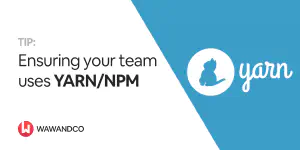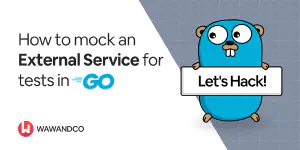-

TIP: Ensuring your team uses YARN/NPM
One common Javascript flaw I see in repositories I get in touch with is the usage of both yarn.lock and npm-lock.json. This is not on purpose, in most cases is due to the lack of communication on the tooling the repo uses or different points of view on the best tooling for the problem at hand. In this short post, I’m not going to focus on communication strategies for the codebase, nor in which one is better between YARN and NPM.Read more -

Testing Buffalo Applications
Buffalo is a great tool to rapidly ship software solutions to the market, inspired by the famous Ruby on Rails framework, it brought Rapid Application Development to the Go Language. I say Buffalo, by far provides the best developer experience among other web development frameworks in Go, but I’m obviously biased by being part of the Buffalo core team. Buffalo’s existence has lead my team at Wawandco to deliver great apps within the last 2 years, and we are still delivering.Read more -

How to mock an external service for tests in GO
Read moreFrom my experience as a software developer, an issue that I have dealt when building an application are the dependencies for external services. A test with external dependencies where you don’t have much control can fail if there is a change in the service and the outcome is not the expected, with this in mind, we need to ensure the non-dependence of external services when running our tests. The most effective way to do this is mocking those dependencies.
In this post, I will focus on the functional tests of an application. I will also talk about how to mock an external service to not rely on it when running our functional tests.
To explain how to mock an external service, I’ll walk you step by step through an example.
Let’s say that we have an endpoint, that is using a third-party package called holidays that is making HTTP requests to an external service to get such holidays.
-

How's it like to write an Android app in 2019?
Read moreFirst, for Java developers only
As Android developers, there are many ways to write an app and get tired of seeing how the lack of features of the Java (Java6 by default) platform embedded in the Android SDK slows the coding process. Notice that Java6 last public update dates from 2013 and that is the version you are expected to use on Android development with Java. You can use Java8 language features but most of the powerful features can only be used in devices that are running Android 7.0 Nougat (API 24).
By May 7, 2019, Android 10 not released yet, there was a total close to 41.9% devices running Android OS prior Nougat out of 2.5 billion active devices.
-

Custom Web Fonts in Buffalo
Read moreIn certain situations the site or app you’re building uses fonts that are not hosted in a CDN. The font is not in Google fonts, and is not in Adobe Fonts or other provider.
You may be given at that point a set of OTF, TTF and WOFF files. But what do do then? How do you integrate those font files in your Buffalo app?. After all, you want your frontend to look as closer to what your designer has put together, And we all know that fonts matter.
What to do?
Assuming you are in your Buffalo app folder, take a look at the
assetssub-folder.- assets > css > images > js -

Testing the Visuals of IE11 & Microsoft Edge on a MAC OS using VirtualBox
Read moreAs developers one of our duties is to ensure consistency in how content is displayed in a variety of browsers. If your web development project involves testing the visuals on
IE11orMicrosoft Edgeand don’t know how because you are using MacOS, then this post is for you! Note that you do not need a serial number or purchase anything in order to install Windows 10.I’ll expose a fairly simple and popular way to operate Bill Gates' giant having Steve Jobs as host using Oracle’s
VirtualBox. The steps are as follows:1. Install Oracle’s
VirtualBox.
2. Install Microsoft 10 using a.isofile inVirtualBox.
3. Testing your project withIE11andMicrosoft Edge. -

How Emergent Design Solved N+1 Problem In Buffalo Pop
Read moreDisclaimer. Those who are not familiarized with N+1 problem, you can check “What is the N+1 selects problem in ORM(Object-Relational Mapping) with details explaining the concept.
Since associations were introduced in Pop, the N+1 problem became part of it: many queries hit the database in order to load whole model’s associations. Good news is N+1 problem is not a disease without remedy. In this post I will give you some steps I took to solve it by incorporating emergent design.
Step 1: Start Coding By Example
Coding by example helps you to define what’s your input and what’s your output. Code By Example means you define a scenario where your solution is tested and what is the expected result. The method I used to apply this technique was Test Driven Development (TDD).
-

Deploying Buffalo to Google Cloud Run
Read moreGoogle Cloud Run is a service that allows you to run containerized applications in a serverless environment. This means that you don’t have to care about servers. Billing is done for what you use in terms of memory and processor for time (Google provides a free tier you can check here).
In this post, I will describe how you deploy your Buffalo application to Cloud Run.
Setup
In order for us to be able to send the app to Google Cloud Run, you need:
- Docker installed
- Gcloud CLI tool installed with the beta components
- Gcloud logged into your google account
- Docker setup with your GCR account
-

Deploying a Buffalo app to Heroku
Read moreA lot of things have changed in the Buffalo ecosystem since my last post on how to deploy to Heroku from Gitlab.
Indeed, everything has changed since I posted how to deploy from gitlab repo into Heroku with the birth of the buffalo-heroku plugin. In this post I will try and describe how to use it to deploy your buffalo app to Heroku.
Setup
First thing you need to install (or ensure you have) is buffalo-plugins plugin. If you’re on buffalo v0.14.6 or higher you’re all set. If you’re on an older version you should:
- Move to your project root folder
- Download and install buffalo-plugins plugin
$ GO111MODULE=off go get -u github.com/gobuffalo/buffalo-plugins